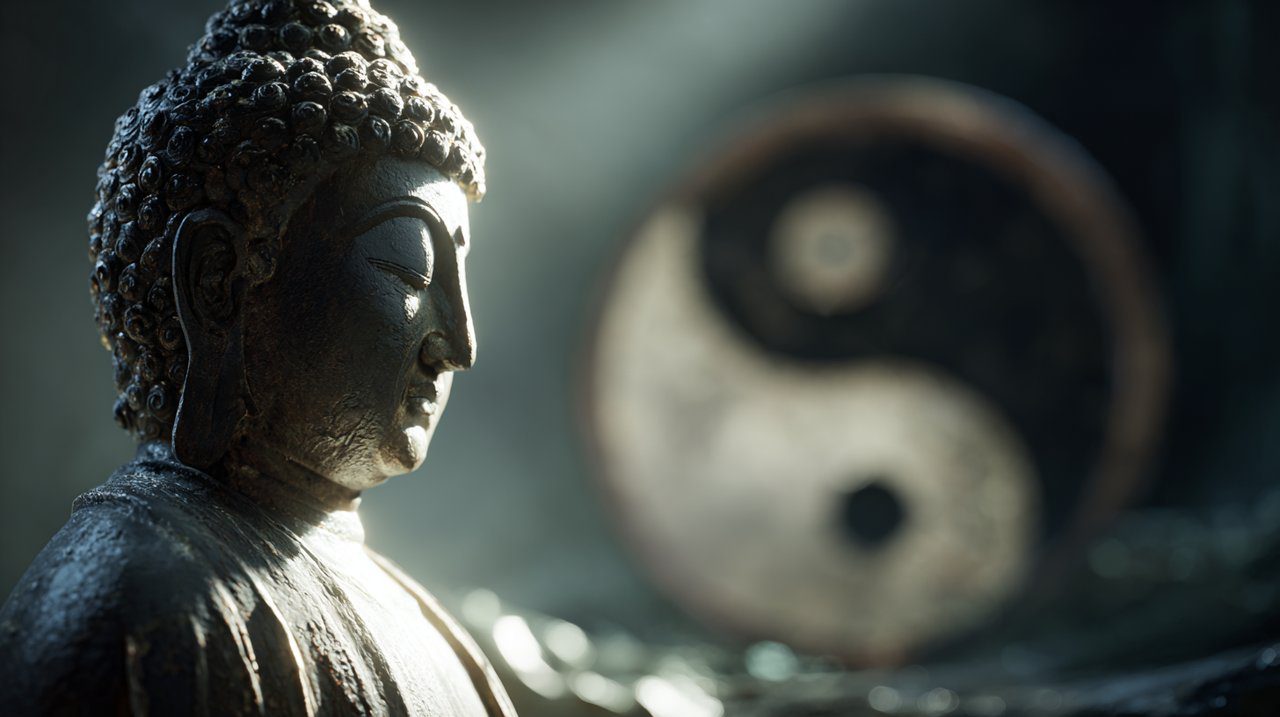Yin Yang Buddha: Nature’s Whisper of Harmonious Balance
Have you ever paused to truly observe the natural world? It holds profound lessons in quiet wisdom. Think about a mountain stream, for instance. One moment, its waters might rush with turbulent rapids, full of vibrant energy.
The next, they gather into serene, still pools, reflecting the sky. Yet, both phases belong to the same continuous flow—a perfect dance of motion and calm. Or consider an ancient tree, with roots delving deep into the earth while its branches reach skyward. It stands as a silent testament to the profound dualities that nurture all life.
This dynamic interplay is the very essence of the Yin Yang Buddha. It’s far more than just an image; it’s a living metaphor for our own existence. This powerful symbol gently invites us to see the world, and ourselves, through the lens of dynamic balance.
It reminds us that seeming opposites are, in truth, interdependent parts of a greater, harmonious whole. Its enduring power comes from its fluidity—a quiet invitation to embrace life’s ever-changing tides with a tranquil heart.

The Yin Yang Buddha: A Modern Synthesis of Ancient Wisdom
The Yin Yang Buddha is a truly compelling contemporary symbol. It masterfully weaves together two profound streams of ancient wisdom. While you won’t find it in historical Buddhist or Daoist texts, it represents a powerful modern fusion.
This resonates deeply with many of us today who seek a more integrated spiritual understanding. This symbol speaks of a reality where light and shadow aren’t adversaries, but eternal partners. Each defines and gives rise to the other.
Its emergence reflects a growing desire to synthesize diverse philosophical traditions. The goal is to find a unified approach to balance and enlightenment in our busy world.
The Eternal Dance of Yin and Yang
At its core, the Daoist concept of Yin and Yang is like the fundamental breath of the universe itself. Let’s consider a familiar scene to grasp this.
Imagine the soft mist clinging to a valley floor at dawn—that’s Yin, receptive and still. Then, watch as it gradually yields to the sun’s first golden rays upon the mountain peaks—that’s Yang, active and illuminating. It beautifully encompasses the receptive darkness of the earth and the active light of the sky.
This isn’t a rigid division, but a continuous, flowing transformation. Think of the relentless ebb and flow of the ocean’s tide: an endless cycle of receiving and releasing.
It’s a powerful reminder that true balance isn’t about eradicating what we perceive as ‘negative.’ Instead, it’s about recognizing its essential, defining role in the whole picture.
The wisdom of Yin Yang teaches that true harmony emerges not from eliminating one side, but from understanding and embracing the constant interplay between them.
The Buddha’s Realm of Wholeness
Complementing this vibrant dance is the Buddha, often depicted in serene contemplation. The Buddha embodies a profound stillness amidst the world’s ceaseless flux. Think of a lotus blossoming unsullied from muddy waters; it shows us that clarity and peace arise not from escaping life’s messiness, but from embracing all its aspects – both the tranquil and the turbulent.
The Buddha’s serene presence within the Yin Yang symbol suggests something truly insightful. True equanimity isn’t found in escaping duality, but in abiding peacefully within its intricate dance. This is a profound wisdom, deeply rooted in the very life and teachings of the Buddha himselfWho Was the Buddha? A Guide to His Life and Wisdom.
Integrating Wisdom: The Yin Yang Buddha in Daily Life
Now, how do we bring these beautiful, abstract concepts into our daily lives? A symbol’s power truly deepens when we integrate it beyond mere thought. For many, a tangible representation of these ideas, like a small pendant or even a smooth stone, becomes more than just an adornment. It transforms into a personal point of contemplation and a constant, gentle reminder.
Imagine that small stone, smooth and cool against your skin. It can become a gentle, constant anchor in the shifting currents of your day. This isn’t about magical properties; true transformation always originates from within you. Rather, such a piece serves as a silent companion.
It’s a subtle, ever-present prompt to notice the currents within yourself. You might observe the surge of energy and the quiet retreat, the fleeting moment of clarity and the cloud of confusion that might follow. It encourages an acceptance of these internal rhythms.
Much like a forest floor where decay feeds new growth, acknowledging these rhythms allows our inner landscape to thrive. It’s a continuous cycle of release and renewal. This practice fosters a deep healing that comes from integrating all parts of our being, leading to profound inner peace.

Pathways to Contemplation: Breath and Inner Observation
We’ve explored the symbol’s essence and its tangible presence. Now, let’s consider how its profound wisdom can be deeply woven into the fabric of your contemplative practices. The key, we’ll find, lies in gentle observation, rather than trying to force a state of balance.
Observation Guided by Nature
In quiet contemplation, the Yin Yang Buddha serves as a gentle guide. It invites you to witness your inner landscape with the same calm gaze you’d offer to the natural world. Just as clouds drift across the sky—ever-changing yet never truly gone—so too do your thoughts and emotions arise and pass within you.
This practice involves simply observing the coming and going of focus and distraction, of comfort and subtle discomfort, all without judgment. This symbol becomes a powerful lens through which to acknowledge these dualities. It allows them to simply be, rather than striving to eliminate one for the other.
It marks a profound shift: from struggling against yourself to simply witnessing the unfolding of your inner experience.
Embracing Motion and Stillness
The rhythm of our own breath offers a perfect, miniature example of Yin and Yang in action. Consider it: an inward tide of receiving, followed by an outward tide of releasing. Each moment is a new wave, yet part of the same vast ocean of being.
To truly incorporate the Yin Yang Buddha into your meditation is to find balance not by achieving some static, unchanging state. Instead, it’s about embracing the dynamic interplay of stillness and motion. Think of the rhythmic flow found in practices like Buddhist chantingWhat is the True Significance of Buddhist Chanting?.
It is to find peace within the ebb and flow, knowing, with quiet certainty, that both are essential—both are life itself.
Symbolic Resonance: A Dialogue with Other Paths
When we consider the Yin Yang Buddha’s unique symbolism in comparison with other designs, its distinctive depth truly becomes apparent. It’s a fascinating study in how deep integration can create something new and powerful.
A pure Yin Yang symbol, on its own, often speaks primarily of cosmic flow and the grand interconnectedness of all phenomena. A solitary Buddha image, conversely, typically points towards enlightenment, liberation, and the cessation of suffering, embodying the core teachings and practices of Buddhism itselfBuddhism Origins, Core Teachings and Practices Explained.
The true magic of the Yin Yang Buddha lies in its masterful bridging of these two profound paths. It’s where cosmic harmony meets inner awakening.
This symbol represents the cosmic dance of Yin and Yang embodied by a tranquil presence. It suggests that true enlightenment isn’t about detaching ourselves from the world’s ceaseless flux. Rather, it’s about cultivating a serene and engaged presence within it.
Unlike a solitary mountain peak, which stands alone in its grandeur, this symbol embraces the valley alongside it. It understands that one defines the other. It speaks not of separation or the transcendence of dualities, but of their profound integration and harmonious coexistence within the awakened heart.
Just as twilight softly blends the last light with the encroaching shadow, or as the river endlessly flows, carving its path yet remaining whole, so too is the enduring wisdom of the Yin Yang Buddha. It is, ultimately, a gentle reminder that life’s deepest truths are often found not in stark separation, but in the tender spaces where opposites meet and gracefully merge.
To walk with this understanding is to move through the world with a quiet strength. It’s about finding balance not in rigid control, but in the graceful dance of acceptance and flow.
So, how can we deepen this contemplative journey and integrate its profound wisdom into every gentle breath? You might find yourself drawn to a small, tangible reminder—perhaps a quiet space for reflection, a simple daily practice, or even the subtle feel of a smooth stone in your hand.
Remember that mountain stream from our opening? It finds its peace in both rapid and pool. In the same way, we too can find our own tranquility in life’s dynamic embrace. It’s a journey of continuous discovery, where every moment offers a chance to live in balance.
💡 Frequently Asked Questions
The Yin Yang Buddha is a symbol representing dynamic balance and the harmonious integration of seeming opposites. It fuses the Daoist concept of Yin and Yang with the serene wisdom of the Buddha, suggesting that true harmony comes from embracing life's dualities.
The Daoist concept of Yin and Yang describes the continuous, flowing transformation and interplay of opposing yet interdependent forces, such as light and shadow, or active and receptive. It teaches that true harmony emerges from understanding and embracing this constant interplay.
The Buddha's presence within the Yin Yang symbol signifies that true equanimity and peace are found not by escaping life's dualities or messiness, but by cultivating a serene and engaged presence amidst them, embracing all aspects of existence.
Its wisdom can be applied through inner observation, watching thoughts and emotions without judgment, similar to observing clouds. It also encourages embracing the dynamic interplay of stillness and motion, like the rhythmic flow of breath, finding peace within life's ebb and flow.








